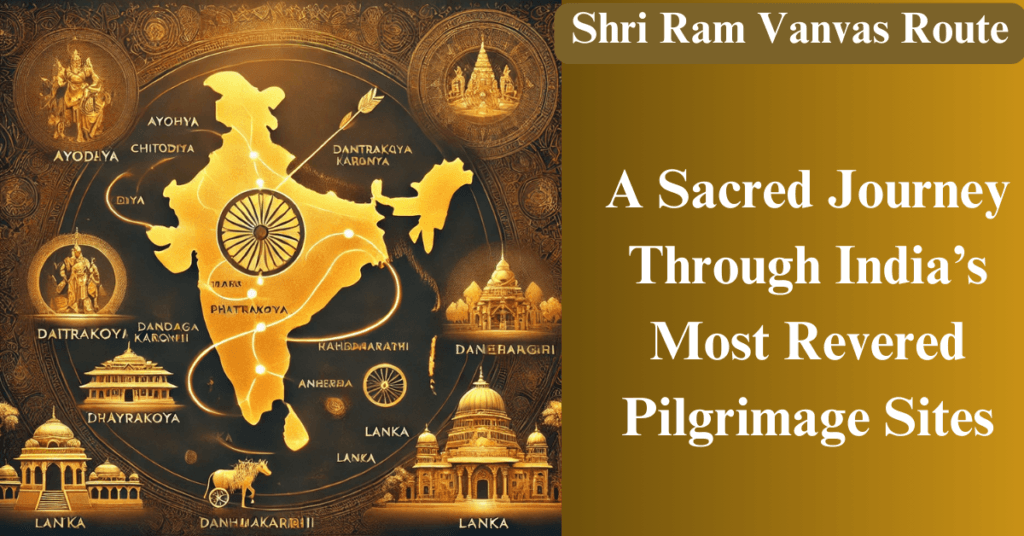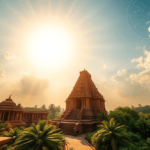
Table of Contents
Shri Ram Vanvas Route
Shri Ram Vanvas Route : Lord Shri Ram’s exile was not just a geographical journey but a saga of sacrifice, devotion, and the establishment of righteousness. His vanvas route includes several historical and religious sites that remain significant places of worship today. In this article, we will explore Shri Ram’s vanvas route and its importance in detail.
Shri Ram’s Vanvas Route: A Divine Journey

1. Ayodhya to Nandigram
The exile began in Ayodhya when Kaikeyi’s boon led to Lord Ram’s departure for 14 years of vanvas. From Ayodhya, he proceeded to Nandigram, where his brother Bharat took charge of the kingdom by placing Shri Ram’s sandals on the throne, ruling on his behalf.
2. Chitrakoot: The First Halt in Exile
From Nandigram, Shri Ram, Mata Sita, and Lakshman traveled to Chitrakoot. This place became their early refuge in exile. It was here that Bharat came to meet Lord Ram and requested him to return to Ayodhya, but Ram decided to fulfill his father’s command.
3. Prayagraj (Allahabad)
Prayagraj is the sacred confluence of the Ganga, Yamuna, and Saraswati rivers. Here, Lord Ram visited the ashram of Sage Bharadwaj and spent some time planning the next part of his journey.
4. Dandakaranya and Ramtek
After leaving Prayagraj, Lord Ram reached Dandakaranya, a vast forest region spread across Madhya Pradesh, Chhattisgarh, and Maharashtra. This place was home to many sages and was troubled by demons. In Ramtek, Lord Ram eliminated several demons, ensuring the safety of the sages.
5. Panchavati and Longar
Panchavati, in present-day Nashik, Maharashtra, is a significant site in Shri Ram’s exile. It was here that Mata Sita was abducted by Ravana. This location also witnessed the Shurpanakha incident and the battle with Khar and Dushan.
6. Anegundi and Mahendragiri
From Panchavati, Lord Ram journeyed southward to Anegundi in Karnataka. At Mahendragiri, he formed an alliance with Sugriva, defeated Bali, and helped Sugriva regain his kingdom of Kishkindha. It was here that Hanuman discovered the location of Mata Sita in Lanka.
7. Malay Parvat and Setubandh
At the coastal Malay Parvat, Lord Ram worshipped Lord Shiva, seeking divine blessings. With the guidance of Nala and Nila, the Vanara army constructed the Ram Setu, a bridge connecting India to Lanka.
8. Lanka Victory and Ravana’s Defeat
Upon reaching Lanka, Shri Ram waged a fierce battle against Ravana, ultimately defeating him and establishing dharma. After rescuing Mata Sita, Lord Ram returned to Ayodhya in the Pushpak Viman.
#ShriRam #Ramayan #VanvasRoute #RamayanTravel #HinduPilgrimage #RamSetu #Chitrakoot #Panchavati #RamMandir #Dharma #SpiritualJourney #RamayanTourism #SacredPlaces #ShriRamLalla #RamBhakt #RamayanHistory
These tags will help enhance the visibility of your article in search engines and social media. Let me know if you need further refinements
Conclusion
Lord Ram’s vanvas route is not merely a geographical path but a lesson in perseverance, patience, and righteousness. His journey teaches us that following the path of truth and dharma leads to ultimate victory. Today, these places remain sacred pilgrimages, inspiring millions with the ideals of Lord Ram.


